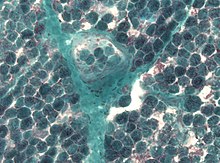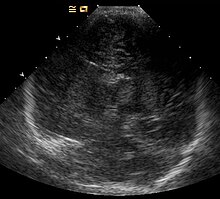Leigh syndrome
| Classification according to ICD-10 | |
|---|---|
| G31.8 | Leigh syndrome |
| ICD-10 online (WHO version 2019) | |
The Leigh syndrome (ger .: Leigh's disease), also known as Crohn's Leigh or subacute necrotizing encephalomyelopathy called, is an inherited disease to the group of so-called mitochondrial belongs. Leigh syndrome is a disorder of the mitochondrial energy metabolism. Many cascades are affected, especially the pyruvate - dehydrogenase and cytochrome c oxidase in the mitochondrial respiratory chain . The inheritance can be autosomal - recessive , X- linked - recessive or maternal.
pathology
The finding is similar to Wernicke encephalopathy , as spongy degenerations and necroses occur in the basal ganglia , cerebellum and brain stem , as well as growths of capillaries and glia in the area of the chiasm , nerve and tractus optici .
Clinic / symptoms
The symptoms of subacute necrotizing encephalomyelopathy are very variable and depend, among other things, on the affected brain region. Many of the following symptoms can occur as early as the first year of life:
- epileptic seizures
- Muscle weakness / paresis
- Hypotension
- Difficulty swallowing (tube requirement)
- Eye symptoms (nystagmus, eye muscle paralysis)
- Breathing disorders
- Developmental delay
diagnosis
- Blood: increased lactate and pyruvate concentration
- CSF and urine sample
- Muscle biopsy: detection of ragged red fibers
Imaging procedures can reveal changes with typical localizations on the brain stem and basal ganglia, as well as signs of leukodystrophy , and contribute to the diagnosis as early as a few months in sonography and later in magnetic resonance tomography .
Differential diagnosis
To be delimited is u. a. the pyruvate dehydrogenase deficiency .
forecast
The prognosis is bad. Life expectancy is only a few years.
Experts hope that a therapy with sirolimus will soon be possible, which should alleviate the fatal mitochondrial disease somewhat. At least in the mouse model, the progression could be slowed down and the survival time increased.
Therapeutic approaches
One therapeutic approach for women who want to have children and who are predisposed to disease in the mitochondria is to remove the nucleus from one of their egg cells and to implant an egg cell from another woman with healthy mitochondria from which the nucleus has been removed beforehand. This experimental approach was undertaken by an American medical team due to legal requirements in Mexico.
Veterinary medicine
In animals, too, a clinical picture of the same name and largely identical to that found in humans has been described. So far it has been detected in Yorkshire Terriers and Alaskan Huskies . In these dogs, Leigh syndrome was fatal within a year of the onset of the disease.
Medical history
The first description of the syndrome dates back to 1951 and was written by Archibald Denis Leigh , a neuropathologist and psychiatrist from Great Britain. He described a 6.5-year-old boy with rapidly progressive developmental disorder who died within six months. A focus of the disease with necrosis and an increase in capillaries (capillary proliferation) in the brain stem were detected in the boy's brain.
literature
- David R. Thorburn, Shamima Rahman: Mitochondrial DNA-Associated Leigh Syndrome and NARP. In: GeneReviews. PMID 20301352 .
Web links
- Leigh syndrome. In: Orphanet (Rare Disease Database).
Individual evidence
- ↑ a b Olav Jansen, Ulrich Stephani (ed.): Malformations and early childhood damage to the CNS. 1st edition. Thieme-Verlag, 2007, ISBN 978-3-13-137591-9 , p. 145.
- ↑ AJ Barkovich: Pediatric Neuroimaging. 2nd Edition. Raven 1995, ISBN 0-7817-0179-1 , p. 97.
- ^ SC Johnson, ME Yanos, E.-B. Kayser, A. Quintana, M. Sangesland, A. Castanza, L. Uhde, J. Hui, VZ Wall, A. Gagnidze, K. Oh, BM Wasko, FJ Ramos, RD Palmiter, PS Rabinovitch, PG Morgan, MM Sedensky , M. Kaeberlein: mTOR Inhibition Alleviates Mitochondrial Disease in a Mouse Model of Leigh Syndrome. In: Science. 342, 6165, pp. 1524-1528. doi: 10.1126 / science.1244360 .
- ↑ Article on Tagesschau.de
- ↑ Erwin Dahmen, Eugen Weiss: Outline of the special pathological anatomy of domestic animals. 6th edition. Enke-Verlag, 2007, ISBN 978-3-8304-1048-5 , p. 274.
- ↑ Leigh AD. Subacute necrotizing encephalomyelopathy in an infant. J Neurol Neurosurg Psychiatry 1951; 14: 216-221
- ↑ Jerome Engel et al.: Epilepsy: A Comprehensive Textbook . Lippincott Williams & Wilki 2007, ISBN 978-0-7817-5777-5 , p. 2627.

